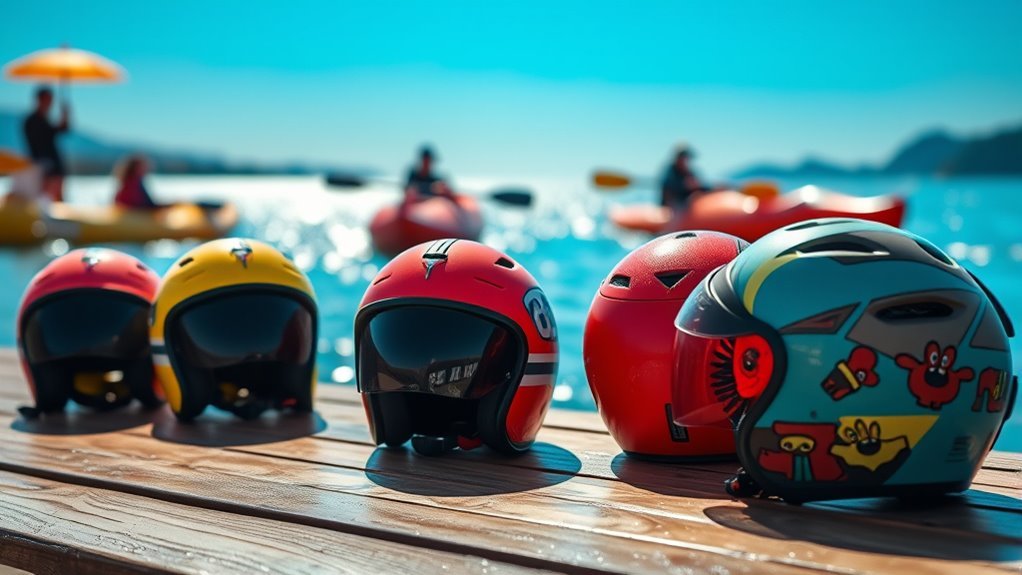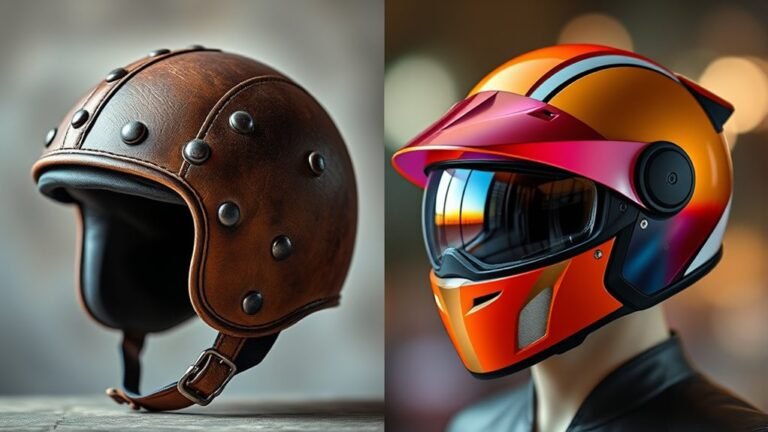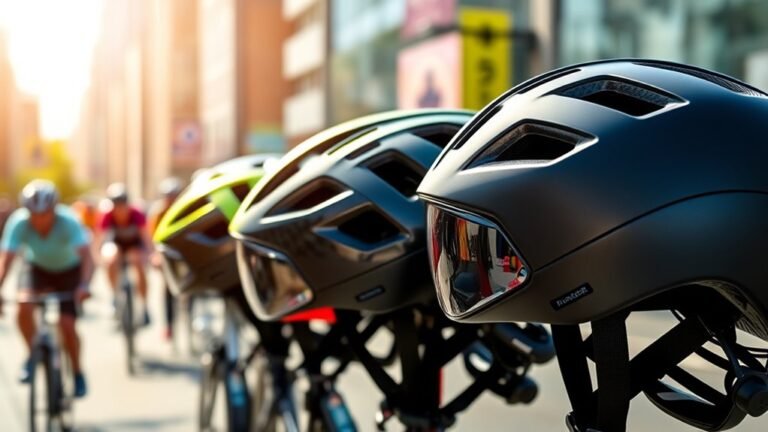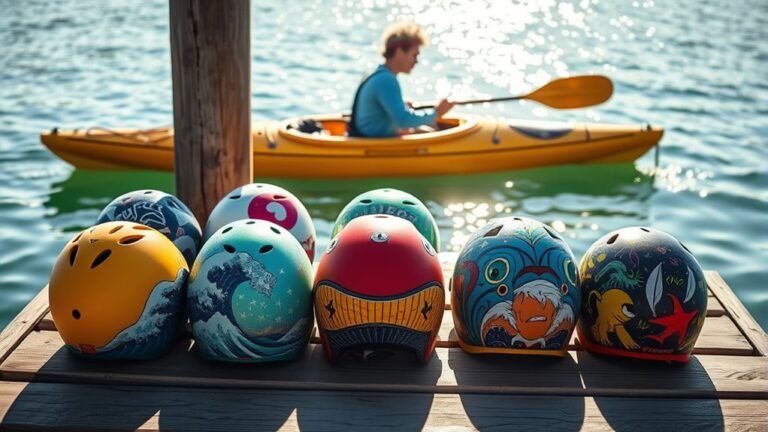Choosing a Helmet for Water Sports: Kayaking and Rafting
Choosing a helmet for water sports like kayaking and rafting is crucial for your safety. Look for a helmet that meets ASTM or CE standards for impact resistance. Make sure it fits snugly and feels comfortable. Depending on your activities, you might want a full face helmet for extreme conditions or a buoyancy helmet for added floatation. Regular maintenance is key for longevity. To guarantee you pick the right one, explore the different types and features available.
Importance of Wearing a Helmet in Water Sports
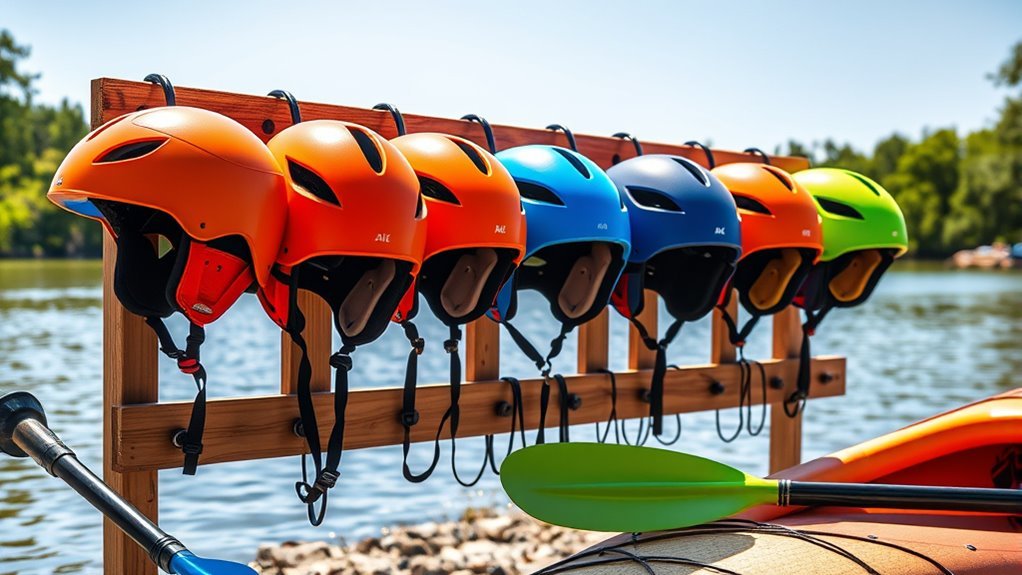
When it comes to water sports, wearing a helmet isn’t just a good idea—it’s essential for your safety. Helmets provide important protection against head injuries that can occur from falls, collisions, or unexpected impacts while you’re enjoying your time on the water. The helmet benefits extend beyond just impact protection; they also boost your confidence, allowing you to push your limits while feeling secure. Safety statistics show that wearing a helmet can greatly reduce the risk of serious head injuries, making it a no-brainer for anyone participating in activities like kayaking or rafting. Embracing this simple yet significant piece of gear means you can fully enjoy your adventure, knowing you’re prioritizing safety without sacrificing the freedom of the open water.
Key Features to Look for in a Helmet

When choosing a helmet for water sports, you’ll want to prioritize impact resistance standards to guarantee maximum safety. Additionally, a proper fit and comfort level are essential for both performance and protection during your activities. Let’s explore these key features further to help you make an informed choice.
Impact Resistance Standards
Choosing the right helmet for water sports is essential, especially since impact resistance can greatly affect your safety. When selecting a helmet, pay attention to impact testing and certification levels. Look for helmets that meet standards set by recognized organizations, such as the American Society for Testing and Materials (ASTM) or the European Committee for Standardization (CE). These certifications indicate that the helmet has undergone rigorous testing to guarantee it can withstand significant impacts. A helmet with high impact resistance will protect your head during unexpected falls or collisions, allowing you to enjoy your adventures with greater peace of mind. Remember, a well-certified helmet isn’t just a piece of gear; it’s your safeguard against potential injuries.
Fit and Comfort
Although safety is paramount, the fit and comfort of your helmet are just as essential for an enjoyable water sports experience. To guarantee you get the right fit, look for helmets with padding adjustments that allow for a customized fit, preventing any movement during your adventure. Choose helmet materials that are lightweight yet durable, such as polycarbonate or ABS plastic, so you won’t feel weighed down while paddling or rafting. Additionally, consider ventilation features to keep you cool during those intense moments on the water. A well-fitted helmet not only protects you but also enhances your freedom, allowing you to focus on the thrill of your surroundings without distractions. Prioritize comfort, and your water sports experience will be even more rewarding.
Types of Helmets for Kayaking and Rafting

Helmets designed for kayaking and rafting come in various types, each tailored to specific water conditions and activities. Choosing the right one is essential for your safety and enjoyment on the water. Here are four types you should consider:
- Full Face Helmets: These offer complete head protection, ideal for extreme conditions or whitewater rafting.
- Buoyancy Helmets: Equipped with flotation features, these helmets help keep your head above water in case of a fall.
- Whitewater Helmets: Lightweight and durable, these are perfect for traversing rapids.
- Touring Helmets: Designed for calm waters, they provide comfort and protection during long paddling sessions.
Understanding Safety Certifications
When you’re selecting a helmet for water sports, understanding safety certifications is vital to guarantee you’re protected while enjoying your time on the water. Look for certification labels that indicate compliance with industry standards, like ASTM or CE. These labels confirm that the helmet has undergone rigorous testing procedures to verify it can withstand impacts and protect your head effectively. Each certification reflects specific performance criteria, so it’s important to choose a helmet that meets your activity’s demands. Don’t compromise on safety; a certified helmet can make all the difference in preventing injuries during unexpected tumbles or collisions. Make informed choices, and prioritize your safety without sacrificing the freedom you crave on the water.
How to Properly Fit Your Helmet
Selecting a helmet with the right safety certifications is just the beginning; verifying it fits properly is equally important for your protection on the water. A well-fitted helmet not only enhances safety but also provides comfort during your adventures. Here’s how to achieve the perfect fit:
- Measure Your Head: Use a flexible tape measure to determine your head shape and size.
- Try it On: Put the helmet on and verify it sits level on your head, covering your forehead.
- Adjusting Straps: Tighten the chin strap so it’s snug but not uncomfortable; it should prevent the helmet from shifting.
- Check for Movement: Shake your head gently; the helmet should stay in place without excessive movement.
Verify your helmet feels secure for ultimate freedom on the water!
Maintenance and Care for Your Helmet
Maintaining your helmet is essential for ensuring its longevity and effectiveness in protecting you during water sports. Regular cleaning is key; use mild soap and a soft cloth to wipe down the exterior and interior after each use. This removes dirt and saltwater, which can degrade materials over time. Avoid harsh chemicals that could damage the helmet’s protective layers.
For storage, keep your helmet in a cool, dry place, away from direct sunlight and extreme temperatures. A helmet bag can protect it from scratches and impacts when not in use. By following these cleaning techniques and storage tips, you’ll keep your helmet in top shape, allowing you to enjoy your adventures freely and safely.
Frequently Asked Questions
Can I Use a Bicycle Helmet for Kayaking or Rafting?
No, you shouldn’t use a bicycle helmet for kayaking or rafting. Bicycle helmets don’t meet the safety standards required for water sports. They’re usually made from materials that aren’t designed to withstand impacts in water environments. Water helmets are specifically engineered for floating, drainage, and better protection against aquatic hazards. For your safety and freedom while paddling, invest in a proper water sports helmet that meets industry standards and is made for water conditions.
How Do I Know if My Helmet Is Too Tight?
If your helmet feels like a vice grip on your head, it’s probably too tight. A proper helmet fit should cradle your head snugly without causing discomfort. You should be able to move your head slightly without feeling restricted. If you notice pressure points or it leaves red marks, it’s time to reassess. Always prioritize comfort level to guarantee safety while enjoying your adventures; freedom shouldn’t come at the cost of your well-being.
What Is the Lifespan of a Water Sports Helmet?
A water sports helmet typically lasts about 3 to 5 years, depending on the helmet materials and how well you maintain it. Regularly inspect for cracks or wear, and clean it after each use to prolong its lifespan. Store it in a cool, dry place away from direct sunlight. By following these maintenance tips, you can guarantee your helmet remains effective, keeping you safe while enjoying the freedom of the water.
Are There Any Specific Brands Recommended for Water Sports Helmets?
When it comes to water sports helmets, brands like Sweet Protection, WRSI, and Shred Ready are highly recommended. They meet rigorous safety standards, ensuring you’ve got reliable protection while enjoying the freedom of your adventures. Each brand offers models specifically designed for kayaking and rafting, combining comfort and safety. Remember, investing in a quality helmet not only enhances your experience but also keeps you safe in unpredictable conditions. Enjoy the water, but always prioritize safety!
Can I Decorate My Helmet With Stickers?
Sure, you can decorate your helmet with stickers! Just remember, “a stitch in time saves nine”—safety first! When choosing sticker materials, opt for ones that won’t compromise helmet safety; avoid heavy or bulky options that could affect fit. Make certain they’re waterproof and won’t peel off easily during your adventures. By personalizing your helmet, you can express your freedom while still keeping safety as your top priority on the water!
